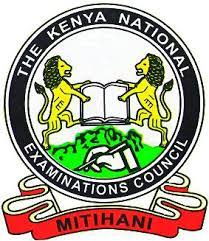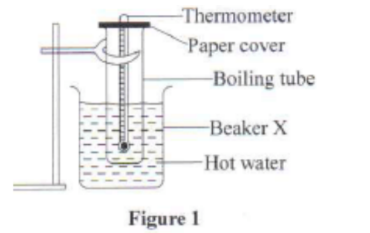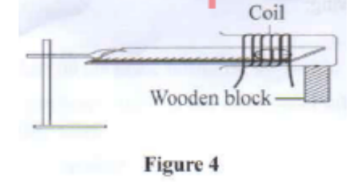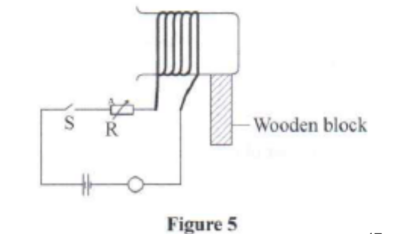
Kenya Certificate of Secondary Education
Practical
2021 Physics paper 3
Question 1
You are provided with the following:
1. A thermometer
2. A boiling tube
3. A retort stand, boss and clamp
4. A weighing balance to be shared)
5. A watch glass
6. A measuring cylinder
7. A beaker labelled X
8. A metre rule
9. An optical pin mounted on a cork
10. Water in a beaker
11. A liquid L in a beaker labelled L
12. A plane mirror
13. A stopwatch
14. Tissue paper
15. A piece of manila paper with a hole in the middle (paper cover)
16. Boiling water (to be provided)
Proceed as follows:
PART A
a. Using the weighing balance, measure and record the mass M. of the boiling tube in grammes.
b.i. Clamp the boiling tube in the retort stand.
ii. Using a measuring cylinder, put 40 cm of cold water in the boiling tube and insert the thermometer in the boiling tube through the paper cover.
iii. Make a hot water bath by putting approximately 500 ml of hot water into the beaker labelled X
c.i. Place the boiling tube in the hot water. Using the thermometer, stir the water in the tube until the temperature rises to 48°C. (See Figure 1)

(Ensure the water in the tube mixes properly to be at the same temperature) ii. With the boiling tube still clamped in the stand, remove the hot water bath. Let the water in the boiling tube cool as you stir throughout using the thermometer.
iii. Immediately the temperature falls to 46°C start the stopwatch and record the time in seconds when the temperature falls to the values shown in Table 1.
HINT: The time recorded is cumulative and the stopwatch should not be stopped until the time at the last temperature (40°C) is recorded. Stirring the water in the tube should also be continuous.
Table 1 (Water) (3 marks)
|
Temperatu
re (oC) |
46 | 45 | 44 | 43 | 42 | 41 | 40 |
|---|---|---|---|---|---|---|---|
| Time(s) |
d.i. Pour out the water from the boiling tube and use some tissue paper to wipe out the water in the tube. Use the measuring cylinder to put 40 cm of liquid L in the boiling tube.
ii. Repeat part c(i), (ii) and (iii) using liquid L in place of water and record the results in the Table 2.
Table 2 (Liquid L) (3 marks)
|
Temperatu
re (oC) |
46 | 45 | 44 | 43 | 42 | 41 | 40 |
|---|---|---|---|---|---|---|---|
| Time(s) |
e. Use the results to determine:
i. time T taken by the water to cool from 45°C to 40°C
T = ……… seconds (1 mark)
ii. time T, taken by liquid L to cool from 45°C to 40°C
T,…………… Seconds (1 mark)
iii. constant K given that K = T2/T1 (1 mark)
f. Given that the densities of liquid L and water are 0.8 gcm-3 and 1.0 gcm-3 respectively determine the:
i. mass ML of liquid L. (2 marks)
ii. mass MW of water. (1 mark)
g. Use the results to determine the constant C given that K(84Mb + 420MW ) = 84Mb + 100MLC (2 marks)
PART B
i. Place the watch glass on the plane mirror on the bench.
ii. Clamp the optical pin horizontally in the retort stand such that its tip is vertically above the pole of the watch glass.
iii. Put a little water into the watch glass. Adjust the height h of the pin above the mirror until it coincides with its inverted image tip to tip. (check for parallax to confirm). See Figure 2.

iv. Measure the height h, of the pin above the mirror.
h1 = ……….. cm (1 mark)
v. Determine r given that r = h1/3 (1 mark)
i. Pour out the water and wipe the watch glass dry. Repeat part h
(iii) using liquid L instead of water
i. Measure and record the height h, of the pin above the mirror.
h2 = ……….. cm (1 mark)
ii. Determine Z given that, Z = h2+r/h2 (2 marks)
Question 2
You are provided with the following:
1. An ammeter
2. 2 cells in a cell holder
3. A coil wound on a beaker
4. A switch
5. A magnetic compass
6. A half metre rule
7. Vemier callipers (to be shared)
8. A retort stand, boss and clamp
9. A wooden block
10. Some plasticine
11. Connecting wires
12. A variable resistor labelled R
Proceed as follows:
a. i. Count and record the number of complete turns N of the coil on the beaker. (1 mark) ii. Use the vernier callipers to measure and record the diameter d of the beaker in metres. (1 mark)
iii. Using some plasticine mount the beaker on the wooden block so that the coil is in a vertical plane.
b.i. Place the compass at one end of the half-metre rule such that the E-W marks of the compass are in a direction parallel to the longest side of the half-metre rule. See Figure 3.(Use some plasticine to fix the compass so that it remains in this position throughout the experiment)

ii. Clamp the other end of the rule in the stand. Adjust the height of the rule above the bench so that the height of the compass needle is approximately equal to the height of the centre of the vertical coil.
iii. With the half-metre rule still clamped, rotate the stand until the north pole of the needle points at 0° of the compass (at N).
(keep the stand in this position throughout the experiment)
c. Move the wooden block such that the compass gets into the beaker and the centre of the coil and that of the magnetic compass needle approximately coincide (See Figure4)

d. With the compass inside the beaker, now connect the coil in series with the cells, ammeter, switch and variable resistor R, as shown in Figure 5.
(Ensure that the ammeter is at least 60 cm away from the compass and that there are no other magnetic materials near the compass.) e.i. Close the switch.
Using the variable resistor adjust the current I so that the deflection 8 of the compass needle is 10° from 0°. Record the corresponding current I in Table 3.
ii. Repeat e(i) for the other values of deflection θ shown in Table 3. Complete Table 3. Table 3 (4 marks)
| Deflection 0° | 10 | 20 | 30 | 40 | 50 | 60 |
|---|---|---|---|---|---|---|
| Current I(A) | ||||||
| Tan 0 |
f. On the grid provided, plot a graph of tan θ(y axis) against current I. (5 marks)

g. From the graph, determine the slope S. (3 marks)
h. Determine the constant k, given that N = Sk1d/4π x 10-7 (2 marks)
i. From the graph, determine the current l, at which the deflection 0 = 45° (1 mark)
j. Determine the following:
i. constant k, given that NI0 = dk2/4π x 10-7 (2 marks)
ii. K, the average value of k1 and k2 (1 marks)
